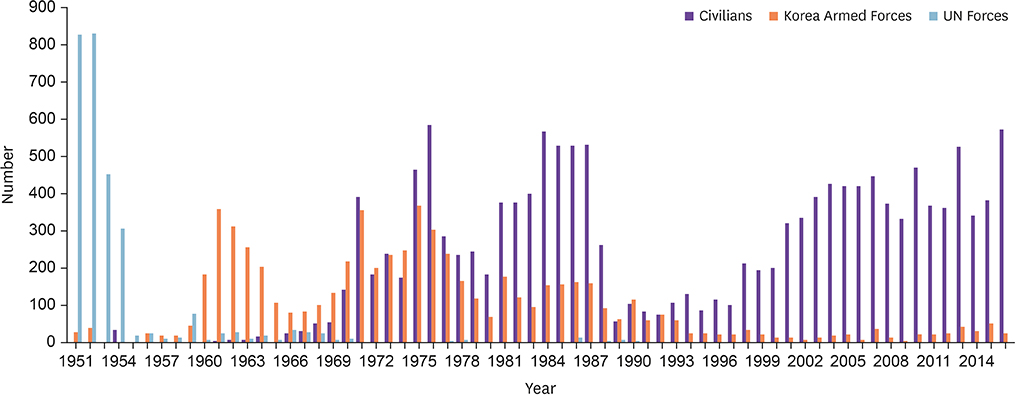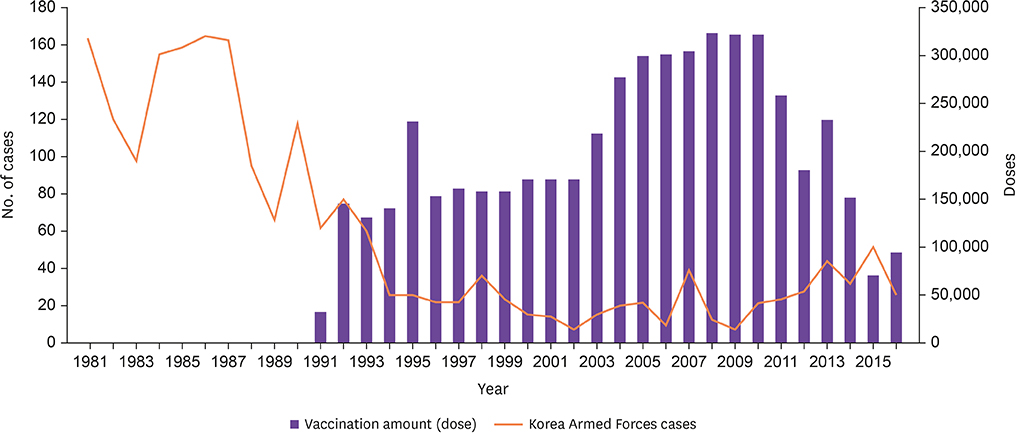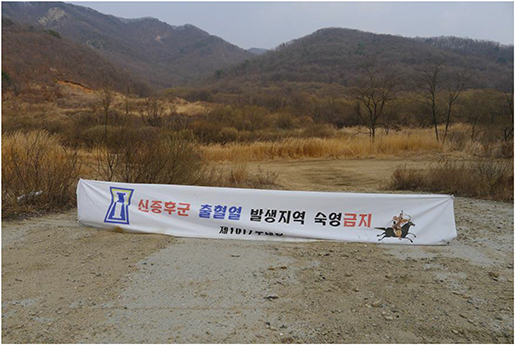Infect Chemother.
2019 Dec;51(4):405-413. 10.3947/ic.2019.51.4.405.
Hemorrhagic Fever with Renal Syndrome
- Affiliations
-
- 1Division of Infectious Diseases, Department of Internal Medicine, Korea University College of Medicine, Seoul, Korea.
- 2Department of Preventive Medicine, Gachon University College of Medicine, Incheon, Korea.
- 3Department of Microbiology, Korea University College of Medicine, Seoul, Korea. jwsong@korea.ac.kr
- KMID: 2466474
- DOI: http://doi.org/10.3947/ic.2019.51.4.405
Abstract
- In Korea, hemorrhagic fever with renal syndrome (HFRS) was first reported in a United Nations (UN) soldier stationed in the central front, also known as the "Iron Triangle". In 1976, professor Ho Wang Lee discovered an antigen in the lung and kidney tissues of Apodemus agrarius. In 1980, this novel virus was named Hantaan virus after the Hantaan river. The Old World Hantaviruses, which are usually found in East Asia and Europe, are generally transmitted to humans via the respiratory pathway during dry seasons, usually in late spring and fall. Currently, 300 - 600 cases per year are reported in Korea with a mortality rate of 1 - 2%. The typical clinical course of HFRS is classified into five phases: febrile, hypotensive, oliguric, diuretic, and convalescent. And treatment for HFRS is mostly conservative. A vaccine for the Hantaan virus was developed in 1988 and marketed in 1990. Because HFRS outbreaks mostly occur in regions near the truce line in Korea, vaccination is virtually the only protection against the virus among military personnel working in such regions and local residents. Therefore, proving the effectiveness of the HFRS vaccine and devising efficient vaccination plans have been considered a major task for Korea's health authorities.
MeSH Terms
Figure
Reference
-
1. Smadel JE. Epidemic hemorrhagic fever. Am J Public Health. 1953; 43:1327–1330.
Article2. Brown WL. Trench nephritis. Lancet. 1916; 187:391–395.
Article3. Casals J, Henderson BE, Hoogstraal H, Johnson KM, Shelokov A. A review of Soviet viral hemorrhagic fevers, 1969. J Infect Dis. 1970; 122:437–453.
Article4. Lee HW. The miracle of the Hantaan River. 1st edition. Seoul: Sigongsa;1999. p. 25–32. p. 246–254.5. French GR, Foulke RS, Brand OA, Eddy GA, Lee HW, Lee PW. Korean hemorrhagic fever: propagation of the etiologic agent in a cell line of human origin. Science. 1981; 211:1046–1048.
Article6. Karabatsos N. International catalogue of arboviruses, including certain other viruses of vertebrates. Texas: American Society of Tropical Medicine and Hygiene;1985. p. 445–446.7. Kim WK, Kim JA, Song DH, Lee D, Kim YC, Lee SY, Lee SH, No JS, Kim JH, Kho JH, Gu SH, Jeong ST, Wiley M, Kim HC, Klein TA, Palacios G, Song JW. Phylogeographic analysis of hemorrhagic fever with renal syndrome patients using multiplex PCR-based next generation sequencing. Sci Rep. 2016; 6:26017.
Article8. Lee MH. Korean Hemorrhagic Fever. 2nd edition. Seoul: Seoul National University Publishing;1986.9. Shin DH, Han SK, Choi PC, Lee YH, Shin DH. Acute abdominal pain in patients with hemorrhagic fever with renal syndrome in the emergency department. J Korean Soc Emerg Med. 2010; 21:191–198.10. Giles RB, Sheedy JA, Ekman CN, Froeb HF, Conley CC, Stockard JL, Cugell DW, Vester JW, Kiyasu RK, Entwisle G, Yoe RH. The sequelae of epidemic hemorrhagic fever; with a note on causes of death. Am J Med. 1954; 16:629–638.11. Lee MC, Cho KS, Yang KH, Park SD. Korean hemorrhagic fever. J Korean Soc Virol. 1979; 9:7–12.12. Lee JK, Hwang SI. Disease history of hemorrhagic fever with renal syndrome. Korean J Med Hist. 2004; 13:37–61.13. Kim YO, Yoon SA, Ku YM, Yang CW, Kim YS, Kim SY, Choi EJ, Chang YS, Bang BK. Serum albumin level correlates with disease severity in patients with Hemorrhagic Fever with Renal Syndrome. J Korean Med Sci. 2003; 18:696–700.
Article14. Kim YS, Ahn C, Han JS, Kim S, Lee JS, Lee PW. Hemorrhagic fever with renal syndrome caused by the Seoul virus. Nephron. 1995; 71:419–427.
Article15. Steer A. Pathology of hemorrhagic fever: a comparison of the findings; 1951 and 1952. Am J Pathol. 1955; 31:201–221.16. Lukes RJ. The pathology of thirty-nine fatal cases of epidemic hemorrhagic fever. Am J Med. 1954; 16:639–650.
Article17. Dodge HJ, Griffin HE, Gauld RL, Kim YS. Epidemic hemorrhagic fever in a Korean farm population. Epidemic observation during 1954. Am J Hyg. 1956; 63:38–51.18. Song JY, Woo HJ, Cheong HJ, Noh JY, Baek LJ, Kim WJ. Long-term immunogenicity and safety of inactivated Hantaan virus vaccine (Hantavax™) in healthy adults. Vaccine. 2016; 34:1289–1295.
Article






